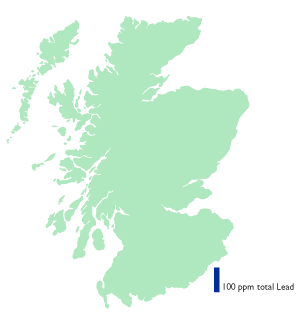Lead
 The average concentration of lead in the Earth's crust is around 13mg/kg but there is considerable variability in natural levels because of inputs from mineralised deposits of lead. However, a major feature of the environmental chemistry of lead (Pb) is the general diffuse pollution in topsoils from a series of sources, including mining and smelting, recycling of sewage sludge and from motor vehicle exhausts. Consequently, lead is known to show significantly enhanced levels in surface soils. Like cadmium, Pb is not thought to have any beneficial effect on living organisms but its detrimental impacts have been the subject of a specific report by the Royal Commission on Enviromental Pollution (Ninth Report, 1983). The symptoms of clinical blood poisoning are wide ranging and it is thought that a blood concentration of 100*g l-1 is lethal. However, there is considerable debate over the impact of sub-clinical levels, particularly in relation to the behaviour and development of intelligence in younger children. For the samples studied here, the Pb contents show a wide variation from 15 to 240 mg/kg. When the mean values for each transect are compared a similar pattern to that observed for the other metals is seen. For transect 1 a mean value of 29mg/kg is found, in transect 2 the mean increases to 64mg/kg, in transect 3 to 180mg/kg before declining in transect 4 to 140 mg/kg. Within each transect, it is more difficult to discern any pattern of change. As with the other metals the values for soils receiving sewage sludge tend to have been adopted as environmental standards for soils and many of the values recorded here are above the recommended (50mg/kg) but below the maximum (300mg/kg) permissable values.
The average concentration of lead in the Earth's crust is around 13mg/kg but there is considerable variability in natural levels because of inputs from mineralised deposits of lead. However, a major feature of the environmental chemistry of lead (Pb) is the general diffuse pollution in topsoils from a series of sources, including mining and smelting, recycling of sewage sludge and from motor vehicle exhausts. Consequently, lead is known to show significantly enhanced levels in surface soils. Like cadmium, Pb is not thought to have any beneficial effect on living organisms but its detrimental impacts have been the subject of a specific report by the Royal Commission on Enviromental Pollution (Ninth Report, 1983). The symptoms of clinical blood poisoning are wide ranging and it is thought that a blood concentration of 100*g l-1 is lethal. However, there is considerable debate over the impact of sub-clinical levels, particularly in relation to the behaviour and development of intelligence in younger children. For the samples studied here, the Pb contents show a wide variation from 15 to 240 mg/kg. When the mean values for each transect are compared a similar pattern to that observed for the other metals is seen. For transect 1 a mean value of 29mg/kg is found, in transect 2 the mean increases to 64mg/kg, in transect 3 to 180mg/kg before declining in transect 4 to 140 mg/kg. Within each transect, it is more difficult to discern any pattern of change. As with the other metals the values for soils receiving sewage sludge tend to have been adopted as environmental standards for soils and many of the values recorded here are above the recommended (50mg/kg) but below the maximum (300mg/kg) permissable values.

